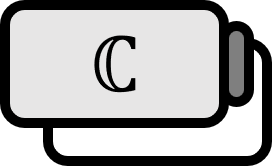The Conditions for the Inverses of Cauchy-Riemann Equations to Hold
Theorem
In the complex domain □ref.□ defined by complex function □ref.□ that takes real values for function □ref.□, $$ f(z) = f(x+iy) = u(x,y) + iv(x,y) $$ can be represented, and if □ref.□ has a continuous first-order partial derivative with respect to □ref.□ and satisfies the system of differential equations, $$ \begin{cases} u_{x} (x,y) = v_{y} (x,y) \\ u_{y} (x,y) = -v_{x} (x,y) \end{cases} $$ then □ref.□ is analytic at □ref.□.
Explanation
Analysis always has the problem of being too wordy and unappealing to read. In short, for the inverse of Cauchy-Riemann equations to hold, the partial derivatives need to be continuous. Naturally, most functions we deal with meet this condition easily.
Proof
Part 1. Form of □ref.□
Without loss of generality, for two real numbers □ref.□, if we set □ref.□, then for □ref.□, $$ f(z+h) - f(z) = [ u(x+\alpha,y+\beta) - u(x,y) ] + i [ v(x+\alpha,y+\beta) - v(x,y) ] $$ can be obtained. Similarly, without loss of generality, if we only consider □ref.□, then by the Mean Value Theorem, $$ \begin{align*} & u(x+\alpha,y+\beta) - u(x,y) \\ =& u(x+\alpha,y+\beta) - u(x,y+\beta) + u(x,y+\beta) - u(x,y) \\ =& [u(x+\alpha,y+\beta) - u(x,y+\beta)] + [u(x,y+\beta) - u(x,y)] \\ =& \alpha u_{x} (x+\theta \alpha,y+\beta) + \beta u_{y} (x,y+\phi \beta) \end{align*} $$ there exist □ref.□ and □ref.□ that satisfy.
Mean Value Theorem: If a function □ref.□ is continuous on □ref.□ and differentiable on □ref.□, then there exists at least one □ref.□ in □ref.□ that satisfies □ref.□.
Here, setting □ref.□ is because when using the Mean Value Theorem on □ref.□ at □ref.□, $$ \begin{align*} {{ \partial u } \over { \partial x }} \left( c , y + \beta \right) =& {{ u(x+\alpha,y+\beta) - u(x,y+\beta) } \over { \left( x + \alpha \right) - x }} \\ \implies \alpha u_{x} \left( c , y + \beta \right) =& u(x+\alpha,y+\beta) - u(x,y+\beta) \end{align*} $$ □ref.□ can be represented as a number □ref.□ between □ref.□ and □ref.□.
Part 2. Form of □ref.□
Now, for some □ref.□ and □ref.□, $$ \begin{align*} u_{x} (x+\theta \alpha,y+\beta) =& u_{x} + \varepsilon_{1} \\ u_{y} (x,y+\phi \beta) =& u_{y} + \varepsilon_{2} \end{align*} $$ if set, since it was stated in the assumption that □ref.□ and □ref.□ are continuous, then when □ref.□, it will be □ref.□. (This is why continuity is necessary.) Therefore, $$ u(x+\alpha,y+\beta) - u(x,y) = \alpha u_{x} + \beta u_{y} + \alpha \varepsilon_{1} + \beta \varepsilon_{2} $$ and in the same way, for some □ref.□ and □ref.□, $$ v(x+\alpha,y+\beta) - v(x,y) = \alpha v_{x} + \beta v_{y} + \alpha \eta_{1} + \beta \eta_{2} $$ can also be set. Returning to □ref.□, since □ref.□ satisfies the Cauchy-Riemann equations, $$ \begin{align*} & f(z+h) - f(z) \\ =& [ u(x+\alpha,y+\beta) - u(x,y) ] + i [ v(x+\alpha,y+\beta) - v(x,y) ] \\ =& [\alpha u_{x} + \beta u_{y} + \alpha \varepsilon_{1} + \beta \varepsilon_{2}] + i [\alpha v_{x} + \beta v_{y} + \alpha \eta_{1} + \beta \eta_{2}] \\ =& h(u_{x} + i v_{x}) + \alpha \xi_{1} + \beta \xi_{2} \end{align*} $$ where □ref.□ and □ref.□. Now, $$ f ' (z) = \lim_{h \to 0} {{f(z+h) - f(z)} \over h} = \lim_{h \to 0} \left( u_{x} + i v_{x} + {{\alpha \xi_{1} + \beta \xi_{2}} \over h} \right) $$ thus, proving □ref.□ concludes the proof.
Part 3. □ref.□
From the inequality $$ \left| {{\alpha \xi_{1} + \beta \xi_{2}} \over {h}} \right| \le { {\max (|\alpha|,|\beta|)} \over {\sqrt{\alpha^2 + \beta^2}} } |\xi_{1} + \xi_{2}| \le |\xi_{1} + \xi_{2}| \le |\xi_{1}| + |\xi_{2}| $$ since $$ \lim_{h \to 0} \xi_{1} = 0 \\ \lim_{h \to 0} \xi_{2} = 0 $$ the following holds: $$ \lim_{h \to 0} {{\alpha \xi_{1} + \beta \xi_{2}} \over h} = 0 $$
■
Renewal
- August 19, 2023, by Daesik Ryu, Focused reinforcement on the Mean Value Theorem content
